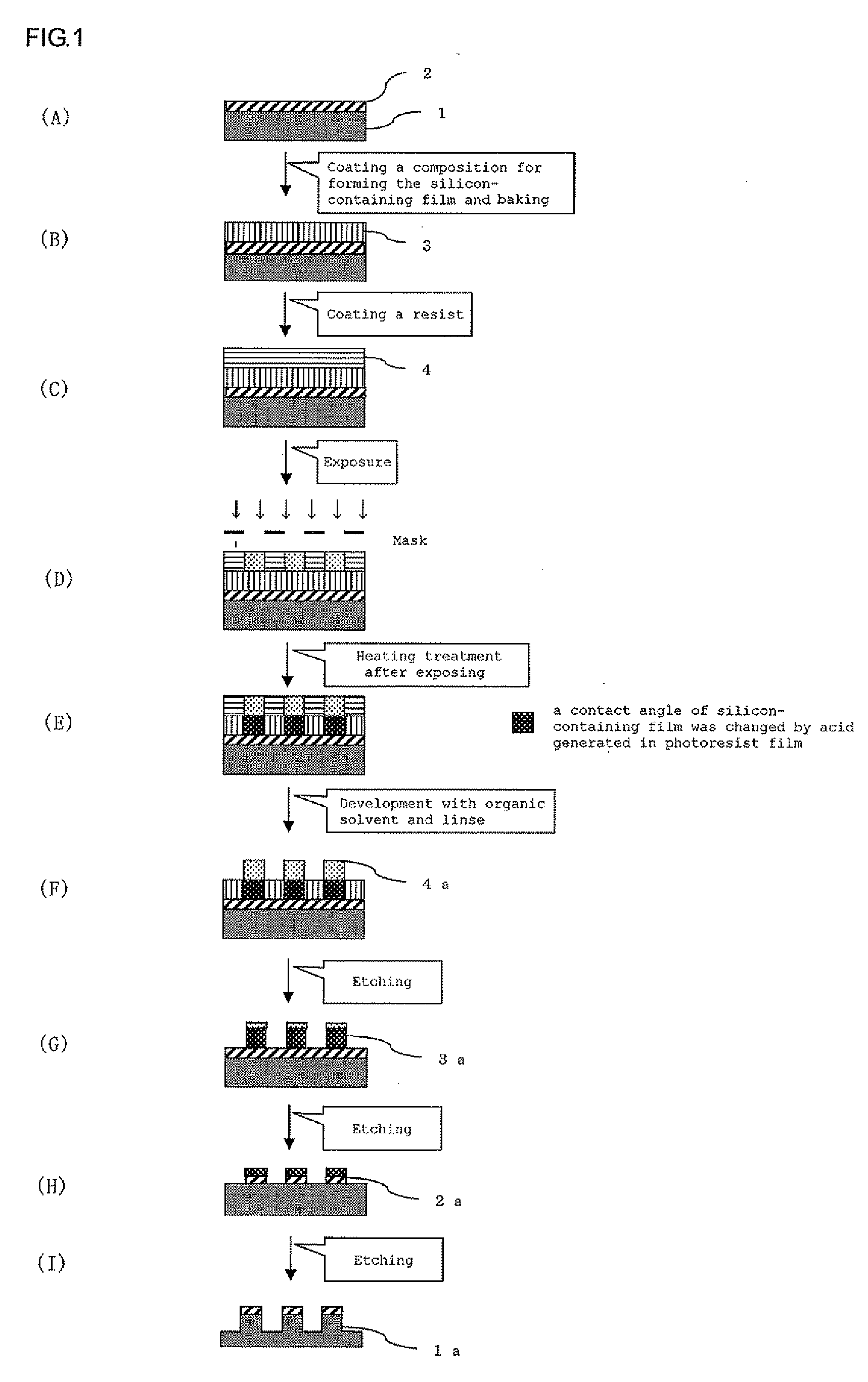Patterning process
a patterning and process technology, applied in the field of patterning process, can solve the problems of changing the optical system, increasing the cost of the scanner, and poor sustainability of the soft, and achieves the effects of reducing the degree of surface roughness, excellent adhesion, and high precision
- Summary
- Abstract
- Description
- Claims
- Application Information
AI Technical Summary
Benefits of technology
Problems solved by technology
Method used
Image
Examples
synthesis example 1
[0226]Into a mixture of 120 g of methanol, 1 g of methanesulfonic acid, and 60 g of deionized water was added a mixture of 42.7 g of 2-(4-methoxy carbonyl phenyl)ethyl trimethoxy silane (monomer 10), 13.6 g of methyl trimethoxy silane (monomer 2), and 52.0 g of tetraethoxy silane (monomer 4); and then the resulting mixture was kept at 40° C. for 12 hours for hydrolysis-condensation.
[0227]After the reaction, 100 g of propylene glycol methyl ether was added thereinto and then by-produced alcohol was removed by distillation under reduced pressure. Then, 1000 mL of ethyl acetate and 300 g of propylene glycol methyl ether were added thereinto, and then a water layer was separated. Into the organic layer remained was added 100 mL of ion-exchanged water; the resulting solution was agitated, settled, and separated into layers. This operation was repeated for 3 times. The organic layer remained was concentrated under reduced pressure to obtain 300 g of a propylene glycol methyl ether solutio...
synthesis example 2 to synthesis example 72
[0229]Each synthesis was conducted in the same manner as Synthesis Example 1 by using monomers shown in Table 1-1 to Table 1-4, to obtain the intended compounds (silicon-containing compounds 2 to 72).
TABLE 1-1Silicon -SynthesiscontaingExampleReactive Starting MaterialMwcompound1monomermonomermonomer3,4001104242.7 g52.0 g 13.6 g2monomermonomermonomermonomer3,60021035242.7 g22.8 g 22.8 g13.6 g3monomermonomermonomermonomer2,40031036242.7 g22.8 g 22.8 g13.6 g4monomermonomermonomermonomermonomer3,700411137241.2 g9.9 g22.8 g22.8 g6.8 g5monomermonomermonomermonomermonomer3,900511138241.2 g9.9 g22.8 g22.8 g6.8 g6monomermonomermonomermonomermonomer2,300611139241.2 g9.9 g22.8 g22.8 g6.8 g7monomermonomermonomermonomer2,10071214245.7 g9.9 g52.0 g 6.8 g8monomermonomermonomermonomer3,20081314245.7 g9.9 g52.0 g 6.8 g9monomermonomermonomermonomermonomer3,700913135245.7 g9.9 g22.8 g22.8 g6.8 g10monomermonomermonomermonomermonomer3,3001013134245.7 g9.9 g22.8 g22.8 g6.8 g11monomermonomermonomermonomer...
PUM
| Property | Measurement | Unit |
|---|---|---|
| Fraction | aaaaa | aaaaa |
| Angle | aaaaa | aaaaa |
| Angle | aaaaa | aaaaa |
Abstract
Description
Claims
Application Information
 Login to View More
Login to View More - R&D
- Intellectual Property
- Life Sciences
- Materials
- Tech Scout
- Unparalleled Data Quality
- Higher Quality Content
- 60% Fewer Hallucinations
Browse by: Latest US Patents, China's latest patents, Technical Efficacy Thesaurus, Application Domain, Technology Topic, Popular Technical Reports.
© 2025 PatSnap. All rights reserved.Legal|Privacy policy|Modern Slavery Act Transparency Statement|Sitemap|About US| Contact US: help@patsnap.com



